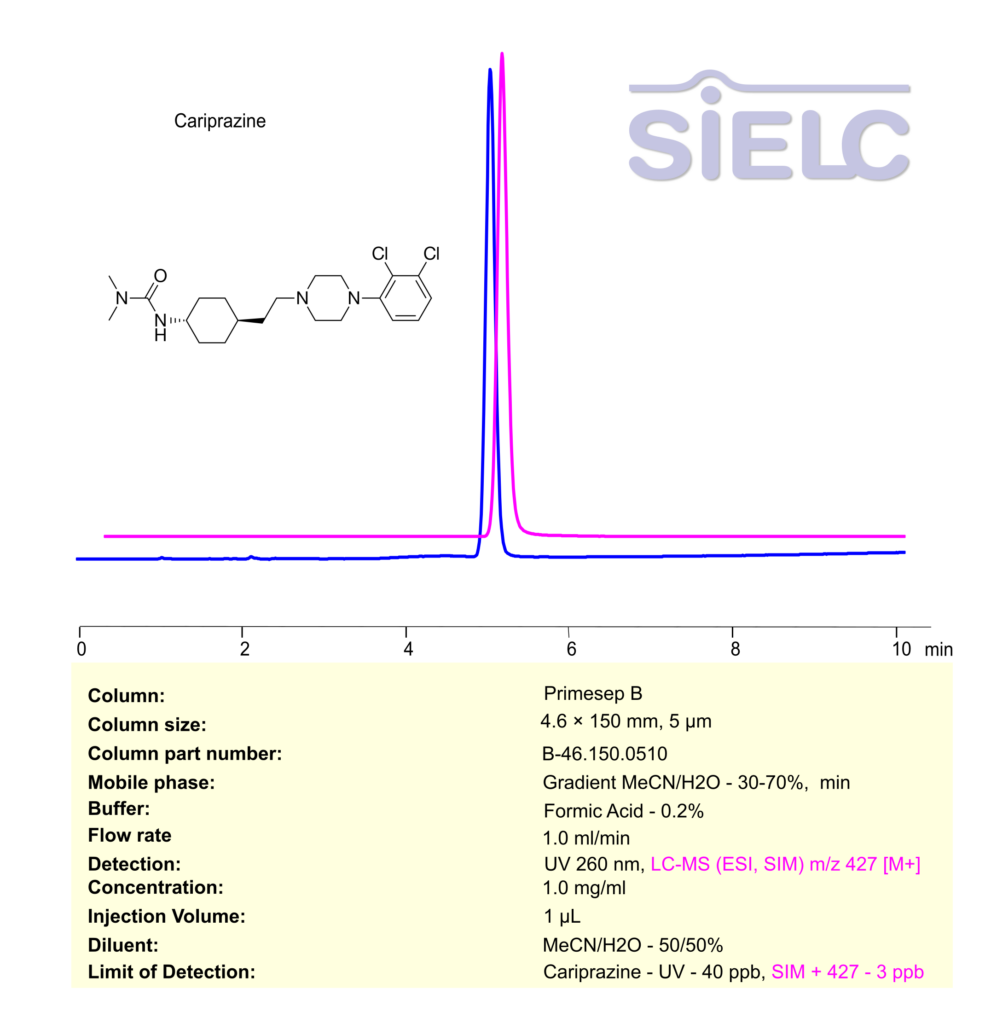
| Molecular Formula | C21H32Cl2N4O |
|---|---|
| Molecular Weight | 427.4 |
| InChI Key | KPWSJANDNDDRMB-UHFFFAOYSA-N |
| LogP | 4.3 |
| Synonyms |
|
Applications:
HPLC-MS Method for Analysis of Cariprazine on Primesep B Column
August 27, 2024
High Performance Liquid Chromatography (HPLC) Method for Analysis of Cariprazine on Primesep B by SIELC Technologies
Separation type: Liquid Chromatography Mixed-mode SIELC Technologies

High Performance Liquid Chromatography (HPLC) Method for Analysis of Cariprazine
Cariprazine is an atypical antipsychotic medication primarily used to treat psychiatric disorders such as schizophrenia and bipolar disorder. It is a dopamine D2/D3 receptor partial agonist, with a preference for the D3 receptor, which helps modulate neurotransmitter activity in the brain. This unique mechanism makes it effective in managing symptoms like hallucinations, delusions, and mood swings.
Brand name: Vraylar (most common)
- Drug class: Atypical antipsychotic
- Mechanism of action: Partial agonist at dopamine D2 and D3 receptors, with some serotonin receptor (5-HT1A) agonism and 5-HT2B/5-HT2A antagonism.
Advantages:
Cariprazine has shown efficacy in treating both the positive (hallucinations, delusions) and negative (social withdrawal, lack of motivation) symptoms of schizophrenia. Its partial agonist effect at D3 receptors may help reduce the risk of some side effects seen with other antipsychotics, such as weight gain or sedation.
Cariprazine can be retained, separated and analyzed using a Primesep B mixed-mode stationary phase column. The analysis employs a gradient method with a simple mobile phase comprising water, acetonitrile (MeCN), and formic acid as a buffer. This method allows for detection using UV 260 nm.
You can find detailed UV spectra of Cariprazine and information about its various lambda maxima by visiting the following link.
| Column | Primesep B, 4.6 x 150 mm, 5 µm, 100 A, dual ended |
| Mobile Phase | Gradient MeCN/H2O – 30-70%, 10 min |
| Buffer | Formic Acid – 0.2% |
| Flow Rate | 1.0 ml/min |
| Detection | UV 260 nm, LC-MS (ESI, SIM) m/z 247 [M+] |
| Limit of Detection | UV 40 ppb, LC MS – 3 ppb |
| Class of Compounds | Drug |
| Analyzing Compounds | Cariprazine |
Application Column
Primesep B
Column Diameter: 4.6 mm
Column Length: 150 mm
Particle Size: 5 µm
Pore Size: 100 A
Column options: dual ended
LC MS Detection

UV-Vis Spectrum of Cariprazine
August 22, 2024
For optimal results in HPLC analysis, it is recommended to measure absorbance at a wavelength that matches the absorption maximum of the compound(s) being analyzed. The UV spectrum shown can assist in selecting an appropriate wavelength for your analysis. Please note that certain mobile phases and buffers may block wavelengths below 230 nm, rendering absorbance measurement at these wavelengths ineffective. If detection below 230 nm is required, it is recommended to use acetonitrile and water as low UV-transparent mobile phases, with phosphoric acid and its salts, sulfuric acid, and TFA as buffers.
For some compounds, the UV-Vis Spectrum is affected by the pH of the mobile phase. The spectra presented here are measured with an acidic mobile phase that has a pH of 3 or lower.


